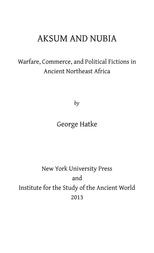Aksum and Nubia: Warfare, Commerce, and Political Fictions in Ancient Northeast Africa
Aksum and Nubia: Warfare, Commerce, and Political Fictions in Ancient Northeast Africa
Cite
Abstract
This book assembles and analyzes the textual and archaeological evidence of interaction between Nubia and the Ethiopian kingdom of Aksum, focusing primarily on the fourth century CE. Although ancient Nubia and Ethiopia have been the subject of a growing number of studies in recent years, little attention has been given to contact between these two regions. This book argues that ancient Northeast Africa cannot be treated as a unified area politically, economically, or culturally. Rather, Nubia and Ethiopia developed within very different regional spheres of interaction, as a result of which the Nubian kingdom of Kush came to focus its energies on the Nile Valley, relying on this as its main route of contact with the outside world, while Aksum was oriented towards the Red Sea and Arabia. In this way Aksum and Kush coexisted in peace for most of their history, and such contact as they maintained with each other was limited to small-scale commerce. Only in the fourth century CE did Aksum take up arms against Kush, and even then the conflict seems to have been related mainly to security issues on Aksum's western frontier. Although Aksum never managed to hold onto Kush for long, much less dealt the final death-blow to the Nubian kingdom, as is often believed, claims to Kush continued to play a role in Aksumite royal ideology as late as the sixth century. This book examines the extent to which relations between two ancient African states were influenced by warfare, commerce, and political fictions.
Sign in
Personal account
- Sign in with email/username & password
- Get email alerts
- Save searches
- Purchase content
- Activate your purchase/trial code
Institutional access
-
Sign in through your institution
- Sign in with a library card Sign in with username/password Recommend to your librarian
Institutional account management
Sign in as administratorPurchase
Our books are available by subscription or purchase to libraries and institutions.
Purchasing information| Month: | Total Views: |
|---|---|
| July 2023 | 1 |
| August 2023 | 1 |
| August 2023 | 2 |
| August 2023 | 3 |
| November 2023 | 1 |
| December 2023 | 1 |
| January 2024 | 5 |
| January 2024 | 4 |
| January 2024 | 6 |
| January 2024 | 3 |
| January 2024 | 3 |
| January 2024 | 5 |
| January 2024 | 4 |
| February 2024 | 1 |
| February 2024 | 2 |
| March 2024 | 5 |
| March 2024 | 3 |
| March 2024 | 2 |
| March 2024 | 3 |
| April 2024 | 3 |
| April 2024 | 1 |
| April 2024 | 1 |
| April 2024 | 1 |
| April 2024 | 2 |



Get help with access
Institutional access
Access to content on Oxford Academic is often provided through institutional subscriptions and purchases. If you are a member of an institution with an active account, you may be able to access content in one of the following ways:
IP based access
Typically, access is provided across an institutional network to a range of IP addresses. This authentication occurs automatically, and it is not possible to sign out of an IP authenticated account.
Sign in through your institution
Choose this option to get remote access when outside your institution. Shibboleth/Open Athens technology is used to provide single sign-on between your institution’s website and Oxford Academic.
If your institution is not listed or you cannot sign in to your institution’s website, please contact your librarian or administrator.
Sign in with a library card
Enter your library card number to sign in. If you cannot sign in, please contact your librarian.
Society Members
Society member access to a journal is achieved in one of the following ways:
Sign in through society site
Many societies offer single sign-on between the society website and Oxford Academic. If you see ‘Sign in through society site’ in the sign in pane within a journal:
If you do not have a society account or have forgotten your username or password, please contact your society.
Sign in using a personal account
Some societies use Oxford Academic personal accounts to provide access to their members. See below.
Personal account
A personal account can be used to get email alerts, save searches, purchase content, and activate subscriptions.
Some societies use Oxford Academic personal accounts to provide access to their members.
Viewing your signed in accounts
Click the account icon in the top right to:
Signed in but can't access content
Oxford Academic is home to a wide variety of products. The institutional subscription may not cover the content that you are trying to access. If you believe you should have access to that content, please contact your librarian.
Institutional account management
For librarians and administrators, your personal account also provides access to institutional account management. Here you will find options to view and activate subscriptions, manage institutional settings and access options, access usage statistics, and more.